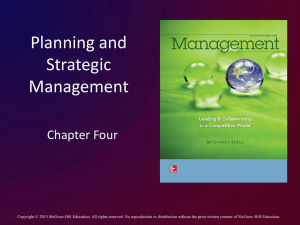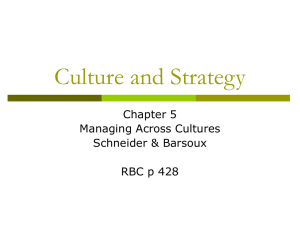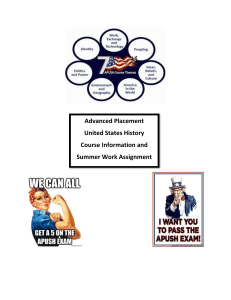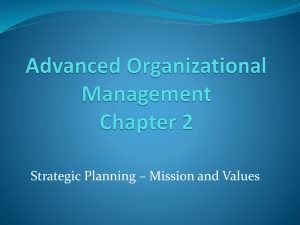Lecture for Chapters 5&6
advertisement
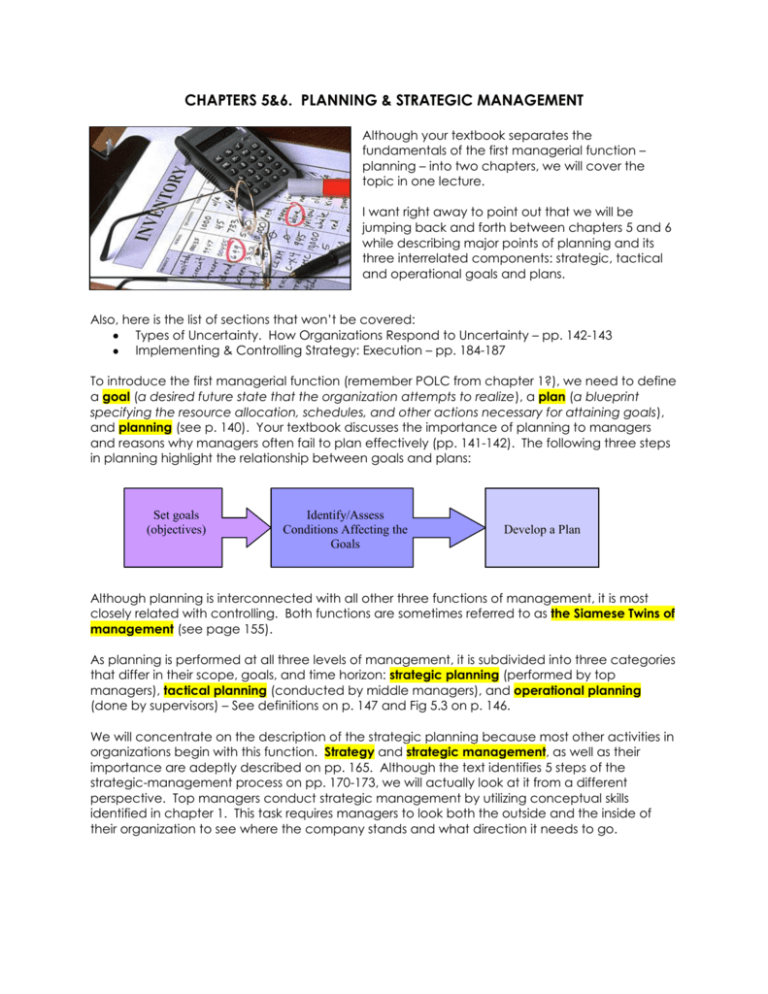
CHAPTERS 5&6. PLANNING & STRATEGIC MANAGEMENT Although your textbook separates the fundamentals of the first managerial function – planning – into two chapters, we will cover the topic in one lecture. I want right away to point out that we will be jumping back and forth between chapters 5 and 6 while describing major points of planning and its three interrelated components: strategic, tactical and operational goals and plans. Also, here is the list of sections that won’t be covered: Types of Uncertainty. How Organizations Respond to Uncertainty – pp. 142-143 Implementing & Controlling Strategy: Execution – pp. 184-187 To introduce the first managerial function (remember POLC from chapter 1?), we need to define a goal (a desired future state that the organization attempts to realize), a plan (a blueprint specifying the resource allocation, schedules, and other actions necessary for attaining goals), and planning (see p. 140). Your textbook discusses the importance of planning to managers and reasons why managers often fail to plan effectively (pp. 141-142). The following three steps in planning highlight the relationship between goals and plans: Set goals (objectives) Identify/Assess Conditions Affecting the Goals Develop a Plan Although planning is interconnected with all other three functions of management, it is most closely related with controlling. Both functions are sometimes referred to as the Siamese Twins of management (see page 155). As planning is performed at all three levels of management, it is subdivided into three categories that differ in their scope, goals, and time horizon: strategic planning (performed by top managers), tactical planning (conducted by middle managers), and operational planning (done by supervisors) – See definitions on p. 147 and Fig 5.3 on p. 146. We will concentrate on the description of the strategic planning because most other activities in organizations begin with this function. Strategy and strategic management, as well as their importance are adeptly described on pp. 165. Although the text identifies 5 steps of the strategic-management process on pp. 170-173, we will actually look at it from a different perspective. Top managers conduct strategic management by utilizing conceptual skills identified in chapter 1. This task requires managers to look both the outside and the inside of their organization to see where the company stands and what direction it needs to go. The field of management is often identified with a Roman god Janus, reason being the importance of incorporating events on the inside and the outside that impact the company’s future. The best illustration of this concept is the preparation step for strategic management known as the SWOT analysis (pp. 174-175). As we will conduct SWOT analyses in our DB (or in class for a face-to-face class), I also wanted to give you some additional links that describe this important managerial process in more detail: Quick MBA, Strategic Management SWOT Analysis for Wal-Mart SWOT Analysis for Starbucks Managing for Quality After we know the organization’s strengths, weaknesses, opportunities and threats, we are ready to develop three parts of the strategic plan: (1) missions statement, (21) organizational strategic goals, and (3) organizational strategic plans. Mission statements are defined in Chapter 5 (p. 145). Although your textbook distinguishes between mission and vision, we will ignore these differences. Characteristics and examples of mission statements are given in chapter 6 on p. 175. Please also see the Center for Business Planning website for more information on how to write a mission statement. A mission statement is the organization’s reason for existence; it is brief and focuses on markets rather than products. Most companies have a mission statement. You will research the mission statement (or a statement of vision) and other aspects of General Electric in your Internet assignment #3. Here are links to a few mission statements of familiar profit, non-profit, and governmental originations: World Bank OSHA Costco Cal State East Bay Union City Police Department ONLINE CLASS ONLY: Here is another opportunity to earn 5 extra points. Please find mission statement for at least three other companies (or organizations) and email these to me by Sunday. Do not attach a formal report, but simply send me those statements with the companies’ names in the body of email. The second step of strategic management is developing strategic goals (see examples for Southwest airlines on p. 149). They focus on using the SMART goals concept (pp. 147-148), which stands for: specific, measurable, attainable, results-oriented, with target dates. The third step is developing strategic plans that allow the company to achieve the aforementioned strategic goals. After strategic goals/plans are developed, specific departments develop their own tactical goals/plans, and then work units develop their operational goals/plans. Your textbook provides a great example of the relationship between strategic tactical operational planning on p. 149 (SWA). If done properly, these three sets of goals/plans contribute to each other: when work units achieve their operational goals, overall tactical departmental goals are achieved, which leads to the overall organizational, strategic goals to be fulfilled. This process is known as a means-end chain, or hierarchy of goals/plans. Using the classification developed by one of the most brilliant modern theoreticians in the field of management, Michael Porter, we can identify grand strategies used by most companies: cost leadership, differentiation, cost-focus, and focused-differentiation. Our text describes the strategies and provides excellent examples on pp. 180-181. You can also check out the QuickMBA, Strategic Management website for more detailed information. You can also buy Porter’s Competitive Strategy at amazon.com, the book in which Porter first developed the four competitive strategies. Another concept that relates to managerial planning and goals’ (objectives) development is known as Management-by-Objectives (p. 151-154). This is a great technique that allows organizations not only to develop goals, but also to improve employee involvement (empowerment), encourage two-way communications between managers and subordinates, and to base performance appraisals on objective standards. Every manager should be familiar with MBO and its advantages. Please research the topic beyond your text by exploring the Business Coach MBO page and the MBO Information webpage. The last couple of terms related to the topic of planning, include forecasting through the techniques of trend analysis and contingency planning (or “what if…” scenarios) – see p. 177.



